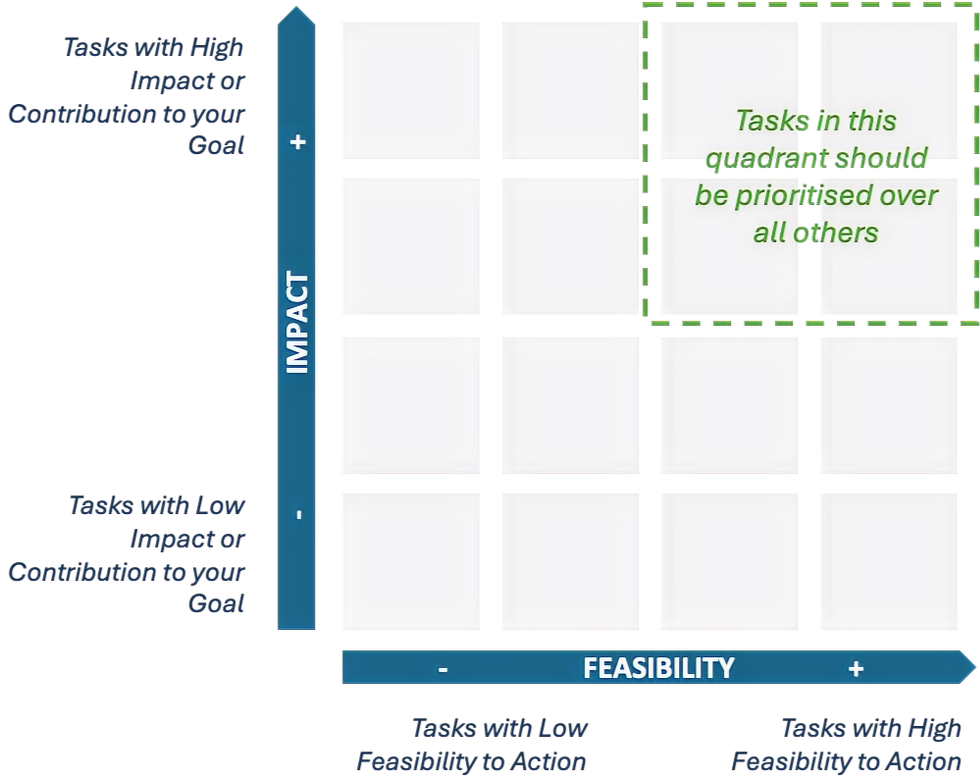How to Prioritise Your Tasks?
- Hugo Pinto

- Dec 3, 2023
- 3 min read
Updated: Jan 29, 2024

Image courtesy of Per Lööv
As business owners and leaders, more often than not, we find ourselves and our teams immersed in the long tail of activities to execute. While most of us enjoy every time we cross out a task on our list, it seems that the tasks multiply by themselves. It would be fair to say that most of us find satisfaction in accomplishing the long list of tasks, but have you ever wondered if you can be more effective by actually doing fewer tasks? What if you can achieve more with less? Okay, let’s be honest, this doesn’t mean you will have spare time – you will most likely use it to do something else – but we can be more efficient with the resources we have.
I will explain a simple tool that has helped me prioritise and has been used by some of my customers with positive results.
Just Before You Prioritise
We can extend this theme for as long as there are multiple approaches or lenses like long-term (1-year / 3-year goals) and short-term (7 – 30 – 90 day goals), by the time of completion, resource availability, by project, you name it. But before prioritising, you have to:
Make sure you have a clear focus on what you want to achieve. More than the task itself, what is the problem or goal you expect the task to contribute to? The clearer you are on this, the better chance you have to tackle it.
How to Prioritise Tasks?
Once you have a clear understanding of what the goal is, I usually conduct a brainstorming. I think of potential tasks that will address the issue. In some cases, you might have this list already in your mind or on your to-do list.
Take the list of potential tasks, actions, or activities and rank them using two simple criteria:
Impact/Contribution towards the Goal
Feasibility to execute it
If you are a visual person, you can create a simple chart, where Impact goes into the y-axis (vertical) and Feasibility into the x-axis (horizontal):

Impact or Contribution is self-explanatory. It refers to how you think the task contributes towards your goal.
Meanwhile, Feasibility refers to how possible it is to execute the task. There are different factors that you might consider like Time to Implement (the more time required, the less feasible), Resources Required (the more money or additional resources required, the less feasible), Control (the less control we have over the task, the less feasible).
The tasks located in the top right corner of the chart will be our top-rank priority as they will contribute the most to addressing the problem or towards the goal and are the ones with the highest probability of implementation.
Let’s illustrate this with an example. Bear in mind, I am oversimplifying…
Example: Company ABC is showing a continuous low level of cash flow and needs to improve it within a quarter.
Brainstorm for potential solutions:
1. Develop and launch a new product.
2. Implement a discount for early payment (AR).
3. Leverage a Line of Credit with the main bank.
4. Restructure.
5. Renegotiate rental contracts.
6. Increase prices.
7. Lower the level of inventory.
8. Review procurement guidelines or alternatives.
In this example, we would focus initially on actions #2 and #3. For the second stage, we would be reviewing #6 and #8.

In some instances, we wouldn’t know exactly where to plot the first task. In this case, we can start plotting where we believe it might go and then use it as a benchmark against the new tasks we are analysing.
While this is not an exact science, this exercise would help us prioritise our list of activities or tasks and make more rational decisions rather than attempting to do them all.
Effective prioritisation is not about doing more; it's about doing what matters most. So, as you face your next task list or your team's list of tasks, invest time to review your final goal and use this prioritisation tool to assess not just the tasks themselves but their potential to propel you closer to your overarching objectives. In doing so, you'll find yourself not just completing tasks, but strategically advancing towards greater success.
Unlock Your Business Potential with our quiz! Discover if you're on track to success in Business Model, Actions, Marketing, and Sales. Take our free quiz now https://avila-consulting-ac01.scoreapp.com/



